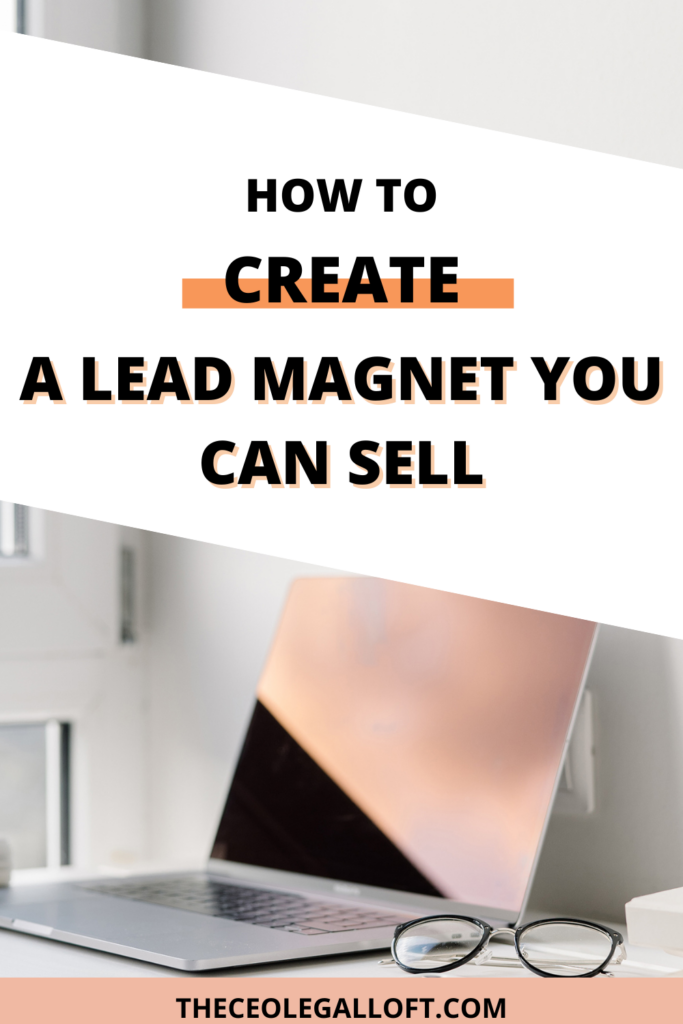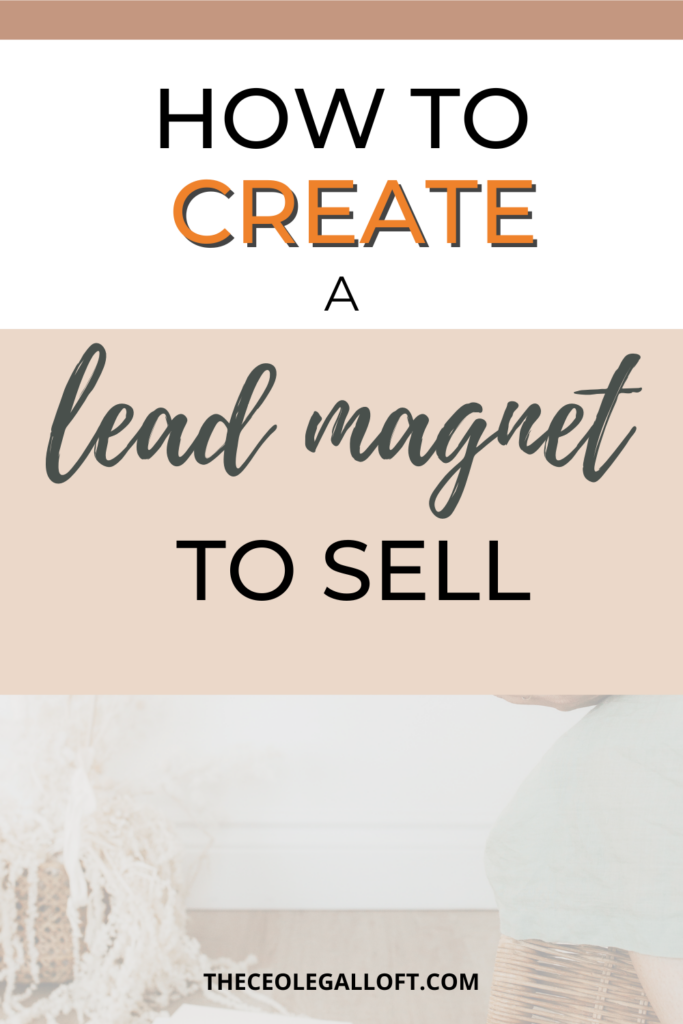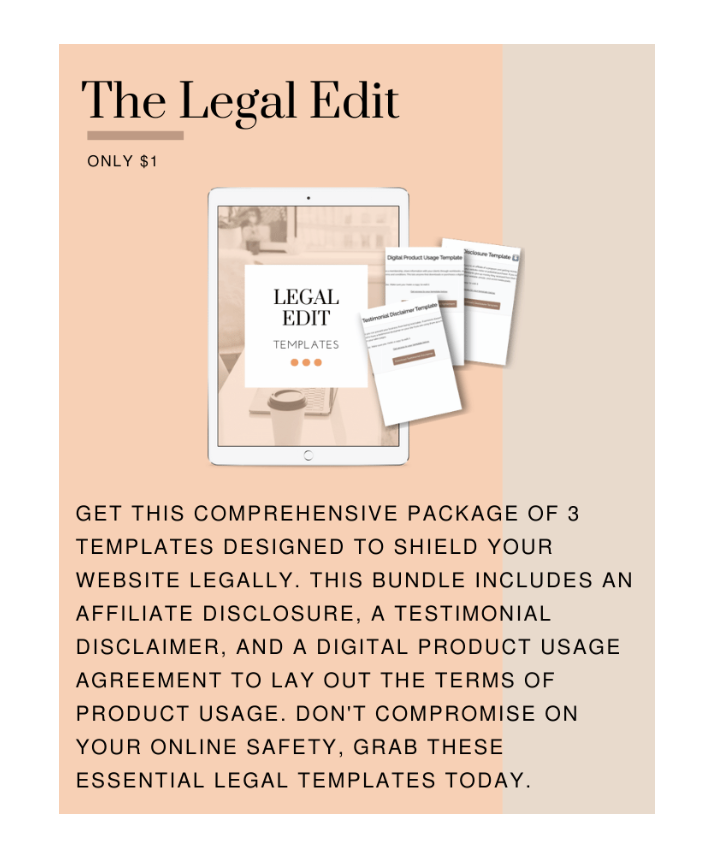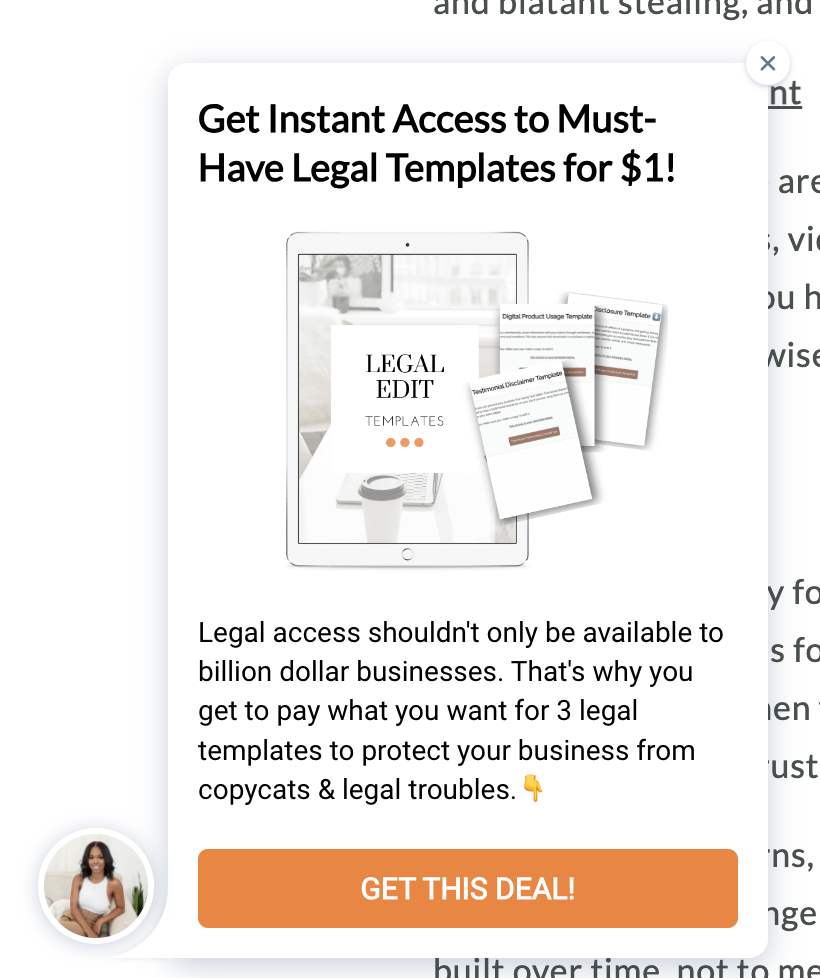You’re either just kicking off your business journey or you’ve been in the game for a while, but either way, you’ve probably heard the buzz about “lead magnets” to build your email list or sometimes called “freebies”. It’s everywhere! But if you’re scratching your head wondering what the heck a lead magnet is, or how to create a lead magnet that has a great conversion rate, you’re in the right place. And in this post, we’re going to discuss how instead of giving away your lead magnet, you can sell it for a teeny tiny amount.
What is a lead magnet?
Imagine walking into your favorite coffee shop, and right by the counter, there’s a sign that says, “Sign up for our newsletter and get a free coffee on your next visit!” Tempting, right? You’d likely key in your email without a second thought. This, my friend, is the magic of a lead magnet in action.
A traditional lead magnet is a marketing tool – a valuable offer usually for free, in exchange for something precious: your potential customer’s contact information. It’s not just about collecting an email address or phone numbers; it’s about building a connection, initiating a relationship, and establishing trust with your potential clients.
But here’s the catch: not all lead magnets are created equal. If you’re looking to create one that truly sells, it needs to be irresistible, unique, and most importantly, valuable to your target audience.
Now, before we get into the nitty-gritty of crafting that perfect lead magnet, let’s understand why it’s such a big deal.
Benefits of a Lead Magnet
- Build Your Email List: The power of an email list is unparalleled. With a lead magnet, you’re not just building a list; you’re gathering a group of interested, potential customers.
- Establishing Authority: By offering valuable information, guides, or tools through your lead magnet, you’re showcasing your expertise. People will begin to see you as an authority in your field, and that trust can lead to sales down the line.
- Deepening Customer Engagement: Offering a valuable lead magnet paves the way for deeper engagement. It’s an entry point for potential customers to enter your world, learn more about your offerings, and eventually buy.
- Cost-effective Marketing: Lead magnets, once created, can be used repeatedly without extra costs. It’s a one-time investment that keeps giving returns.

How to Create Lead Magnets That Your Audience Wants
Ask them
This might sound oversimplified, but the most direct way to know what your audience wants? Just ask them! Engage with your current customers or followers:
- Surveys and Questionnaires: These are gold mines for gathering data. Frame questions that dig deep into what they’re struggling with or what they’d love to learn about.
- Social Media Polls: Platforms like Instagram and Facebook have made it super easy to run quick polls. It’s informal and allows for spontaneous responses. Victoria Boyd has a great training on using stickers on IG stories, including using social media polls.
- Feedback Forms: If you’ve already sold products or services, ask buyers what additional information or tools could help them. Their answers can provide great insights.
Make the outcome very specific
People love clarity and being told exactly what to do without much thinking. Instead of saying, “Learn how to market your business,” say “Get the exact template to create an Instagram bio that attracts your dream client.” Being precise:
- Sets Clear Expectations: Your audience knows exactly what they’ll get out of it.
- Enhances Perceived Value: A specific outcome often feels more actionable and valuable than a broad one.
- Reduces Skepticism: When you’re precise, it feels more achievable, making people more likely to trust (and thus, sign up).
Make it easy to implement
The best lead magnets are those that provide quick wins. They shouldn’t just give information, but actionable steps that are:
- Simple: Your audience shouldn’t need a PhD to implement your advice. Break things down into bite-sized actions.
- Fast: If your audience can see results quickly, they’ll be more convinced of your expertise and more likely to engage with your other offerings.
- Resource-Light: The best strategies don’t always require hefty investments. Showcase tactics that require minimal resources but deliver results.
Choose What Type of Lead Magnet You Will Offer
Not all lead magnets look the same. Depending on your business and audience, different formats might work better:
- Ebook: Perfect for in-depth looks at a particular topic. Great for businesses that thrive on expertise. Usually these are in PDF form and you can store them on your Google Drive or Drop box.
- Checklists, Cheat sheet, and Templates: Ideal for businesses that offer strategies. They give people a framework to start. You can check out my $ 1 offer lead magnet which are 3 legal templates to help online business owners legally protect their digital products and website.
- Audio course (private podcast)/Video tutorials: If your strengths lie in teaching or demonstrating, this could be your best bet. Plus, they position you as an expert in real-time. The great thing about audio files is that people can listen on the go. Everyone’s so busy now, having this as an option will definitely entice people to hand over their email or a nominal monetary amount.
- Discounts and Free Trials: Perfect for product-based businesses. They give people a taste of what you offer, hoping they’ll come back for more.
If you’re looking for lead magnet ideas that you can turn into a tiny offer, check out the 220 $1 offer ideas.

Tools to Create & Sell Your Lead Magnet
In the digital era, there’s no shortage of tools to make your life easier. From design to delivery, various platforms can help you craft an impressive lead magnet and ensure it reaches your audience seamlessly. Let’s look at some of the best ones out there:
Canva
Canva isn’t just another graphic design tool; it’s a gateway to make your ideas visually come alive. In the realm of lead magnets, aesthetics matter. A well-designed guide or infographic not only looks professional but also adds perceived value. Canva offers this advantage without demanding design proficiency. With its vast array of templates and easy drag-and-drop features, it empowers creators to produce eye-catching visuals that resonate with their target audience.
Checkout system
But once you’ve got your lead magnet looking pristine, how do you monetize it? Enter checkout systems like ThriveCart, SendOwl, and Gumroad. These platforms seamlessly blend with your workflow, allowing you to not just offer your lead magnet but to truly sell it. With a plethora of payment options and integration capabilities, they simplify the monetization process, ensuring your lead magnet becomes a revenue stream and not just a marketing tool. You can create a landing page as well as deliver the lead magnet through them.
If you’re looking for a full funnel with order bumps and upsells, go with a tool like ThriveCart. Since this is usually a person’s first interaction with you, a shopping cart may be too overwhelming, if you have a bunch of products to offer.
Email Marketing
Now, delivering your lead magnet is a crucial step. An email marketing system takes care of this with finesse. Whether you’re delivering a freebie or a purchase confirmation, a robust email system ensures your content reaches its destination. Automated sequences, segmentation tools, and captivating templates make it easier than ever to keep your audience engaged and informed. I recommend Convertkit, but have also heard great things about ActiveCampaign and Drip. If you like basic with robust features, go with Convertkit.
Course platform
If your lead magnet ventures into the world of courses, a course is indispensable. Crafting a course is different from writing a blog or creating an infographic. It demands structure, interactivity, and engagement. Platforms tailored for course creation offer these features, allowing creators to focus on content without getting bogged down by the technicalities. Thrivecart has a built in platform Learn+, but there’s others like Teachable or Kajabi.
Screen recording
But what if your content is more dynamic? What if you’re offering software demos, tutorials, or walkthroughs? Screen Recording tools like Loom and QuickTime come to the rescue. They’re not just about capturing what’s on your screen; they’re about narrating a story, guiding users, and offering real-time insights. With intuitive recording and editing features, they ensure your audience gets the best visual learning experience.
Audio hosting
Lastly, the world is quickly recognizing the power of audio. If your lead magnet is an exclusive podcast or an audio guide, platforms like Helloaudio, Trebble, or even a secret page on your website with the embeddes audio can be your best allies. They offer a unique listening experience, making your content accessible on-the-go, and adding a touch of exclusivity to your lead magnet.
- Helloaudio and Hiro.FM are private podcast hosts that you can use.
- Trebble is an audio editor where you can record on their website. They create a transcript and you can edit the audio using the transcript. No more having to listen to audio over and over to find where the “UM”s and silences are hidden. I used it for my private podcast for my challenge and I love it. Took about 5 minutes to record and 5 minutes to edit.
Why I Sell My Lead Magnet
When we think of lead magnets, our minds usually drift towards freebies—little nuggets of value we give away to nurture and grow our audience. Yet, in my journey, I’ve discovered that offering my lead magnet for a modest $1 isn’t just a business strategy, but an affirmation of its worth and a commitment to genuine user engagement.
1. More Likely to Implement:
One of the profound truths I’ve come across is that when people pay, even if it’s a nominal amount, they’re more inclined to utilize what they’ve purchased. It’s the principle of perceived value. A lead magnet procured for free might sit untouched in someone’s downloads folder. However, when a dollar is exchanged, there’s an inherent motivation to extract value from that investment. It’s no longer just another free resource; it’s a micro-investment, demanding attention and implementation.
2. Resentment from Over-Giving:
I pride myself on being a content creator, pouring my heart, soul, and expertise into every piece I craft. And while I’m generous with my knowledge, constantly offering premium content without any compensation started feeling imbalanced. It’s not just about the money; it’s about respect and appreciation for the craft. By attaching a modest price tag to my lead magnet, I found a way to strike a balance between generosity and value recognition.
3. Compensation for Intellectual Property:
We live in a digital era where the fruits of intellectual labor are often undervalued. Just because content is intangible doesn’t mean it’s devoid of value. The hours of research, expertise, and unique insights that go into creating a lead magnet deserve recognition. Charging a nominal fee for my lead magnet isn’t about profiteering; it’s a statement. It acknowledges that intellectual property, even when generously shared, has worth, and creators deserve their due.
Opting to charge $1 for my lead magnet was a decision rooted in understanding both the psychology of consumers and the ethos of a content creator. It serves as a gentle reminder that while sharing knowledge is vital, honoring the labor, expertise, and heart behind that knowledge is equally crucial. And for those who join me on this journey by investing that dollar, it promises them not just content, but content they’ll value, implement, and benefit from.
Where to Promote Your Lead Magnet
Crafting a compelling lead magnet is only half the battle won. The next vital step is ensuring it reaches your target audience. And in our digitized world, there are free platforms where you can showcase your creation. Here’s some that come to top of mind:
Blog
Why: Your blog is a space where readers already come seeking valuable content. It’s a natural habitat for your lead magnet.
How: Embed a call-to-action within relevant articles or at the end of every post. The key is to make it contextual. If readers find your post beneficial, they’d be more inclined to delve deeper with a related lead magnet. If you don’t want to create your own blog on your website, you can utilize something like Medium.
Social Media
Why: Platforms like Twitter, Facebook, Tiktok and Instagram boast billions of users. It’s where conversations happen, trends are set, and content goes viral.
How: Craft engaging posts showcasing the benefits of your lead magnet. Use captivating visuals, run targeted ads, and don’t shy away from leveraging influencers in your niche. See an example of one of my TikToks promoting my $1 lead magnet.
Why: Unlike other social media platforms, Pinterest operates much like a search engine. It’s visual, it’s niche, and it’s where people go to discover and save ideas.
How: Design captivating pins that highlight your lead magnet. Use keyword-rich descriptions and pin them to relevant boards. Remember, consistency is key on Pinterest.
Side bar on your website
Why: As visitors browse your website, the sidebar remains consistently in view, making it prime real estate for promotions.
How: Embed a visually appealing banner or widget. Make sure it stands out but doesn’t clash with the overall aesthetics of your site. See my example below:

Pop up on your website
Why: Pop-ups, when done right, can capture attention without being intrusive.
How: Design a pop-up that triggers after a visitor has spent a certain amount of time on your site or is about to exit. Keep the design clean, the copy concise, and always give users an easy way to close the pop-up if they’re not interested. See an example of my popup using Convertbox.

Your email list
Why: Your email subscribers have already shown interest in your content. They’re a warm audience, making them more likely to be interested in your lead magnet.
How: Craft compelling newsletters that not only introduce your lead magnet but also explain its value proposition. Segmentation can also be beneficial; tailor your message based on subscriber behavior or interests. For anyone that’s already purchased my lead magnet, I also try to upsell on the order bump and upsell at a later date when they didn’t buy at the time of the first purchase.
Facebook Groups
Why: These groups are communities of like-minded individuals. If you find groups that align with the subject of your lead magnet, you have a captive audience.
How: Engage genuinely in the group. Instead of just dropping links, participate in discussions, offer value, and introduce your lead magnet contextually, ensuring it aligns with group rules and etiquette. I also try to find groups where I know they’ll let me promote on certain days.
Find out the results of what happened when I turned my free lead magnet into a $1 offer
Navigating the realm of lead magnets can be a maze of trials and errors. But with the right strategies, even going against the grain, like changing your lead magnet from a freebie to a tiny $1 offer, can become a game-changer. My journey from a freebie to $500 is living proof of the immense power of strategic marketing and the potential lying dormant in our lists.
The internet is saturated with “get rich quick” schemes and generic “growth hacks.” But this training is neither. It’s a chronicle of a real experiment, with tangible results and actionable insights. So, if the idea of growing your email list with genuine buyers appeals to you, this is one training you don’t want to miss. Learn more inside of the case study where I show you how I turned a $1 offer into $500.

This is such an in-depth informative post thank you! Pinning. Question: is a lead magnet similar to the process of MRR courses that seem to be everywhere right now?
Thank you! And absolutely not. I don’t know what MRR is but it sounds like a scam lol. A lead magnet is just something that helps you get people on your email list.
You should be educated enough to not call something you haven’t researched a “scam”🙄 I might actually be giving you too much credit. Jesus what happened to “I’m not educated enough on that topic to give you answer. Let me do my research and get back to you.”
Oh no. I meant what I said when I said MRR is a scam. Especially as more info about it has come out. 🙂
Thank you for the tips! Quick question: what do you recommend doing when you haven’t built an audience yet? Like, how can you know what they need if they don’t interact with you? Thanks in advance.
Story of my life! Luckily you have a tool I didn’t have back in 2019 when I was getting starting and that’s ChatGPT! So I would say try ChatGPT as well as look at comments under Amazon business books in your niche. I’ve gotten some of my ideas for products from those. I talk more about this in my training Create a Digital Product That Sells if you want to check it out.